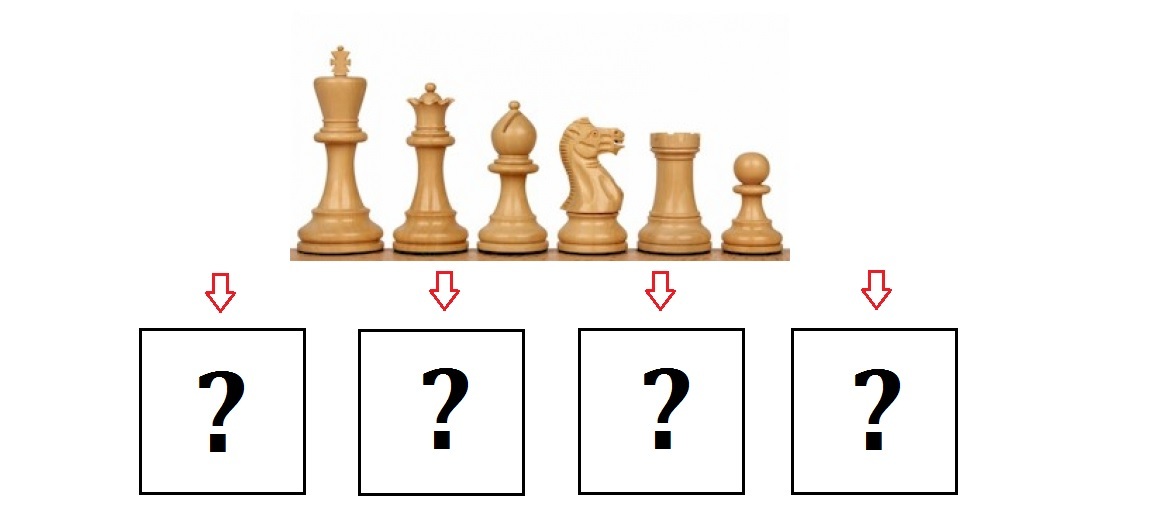The pawn can't stand alone!

There are 6 chess pieces you'd like to put into 4 identical transparent boxes for display: King, Queen, Bishop, Knight, Rook, & Pawn.
How many ways can you arrange all the 6 pieces such that there are no empty boxes and that the pawn is not presented alone in one box?
The answer is 40.
This section requires Javascript.
You are seeing this because something didn't load right. We suggest you, (a) try
refreshing the page, (b) enabling javascript if it is disabled on your browser and,
finally, (c)
loading the
non-javascript version of this page
. We're sorry about the hassle.
3 solutions
how can you take 4 cells in order to place 5 object. We are not allowed to put any object in the cell having pawn already.
We are asked the number of ways in which 6 chess pieces (Ki, Q ,B ,Kn, R and P) can be arranged in 4 identical boxes such that in no arrangement a Pawn is left alone. Let's start by distributing the pieces that can be left alone. Since there are 5 such pieces and only 4 boxes, exactly one box will have 2 pieces instead of one (pigeonhole principle). Problem becomes how many unique pairs are possible and the answer is 10.
1> (Ki, Q) (B) (Kn) (R) 2> (Q) (Ki, B) (Kn) (R) 3> (Q) (B) (Ki, Kn) (R) 4> (Q) (B) (Kn) (Ki, R) 5> (Ki) (Q, B) (Kn) (R) 6> (Ki) (B) (Q, Kn) (R) 7> (Ki) (B) (Kn) (Q, R) 8> (Ki) (Q) (B, Kn) (R) 9> (Ki) (Q) (Kn) (B, R) 10> (Ki) (Q) (B) (Kn, R)
Now the pawn can be dropped into one of the 4 boxes of every distribution and there are 10 such distributions. There are 40 possible arrangements in which pawn is not left alone.
Relevant wiki: Distinct Objects into Identical Bins
In case of distributing n distinct objects into r identical bins, the notation can be written as the Sterling number S ( n , r ) or { r n } .
Naturally, if 6 objects are to be placed into 4 identical bins, the number of combinations will equal { 4 6 } .
However, since we don't want the cases with lone pawns, we have to subtract the former expression with this exception first. For this exclusion, once a lone pawn is put into a box, there will be 3 boxes left for the other 5 pieces. Therefore, the combinations for this equals { 3 5 } .
Thus, our desired solution = { 4 6 } − { 3 5 }
And by using recurrence relations, the generalized formula for any Sterling number is: { r n } = r { r n − 1 } + { r − 1 n − 1 } .
In other words, { r n } − { r − 1 n − 1 } = r { r n − 1 } .
That is, { 4 6 } − { 4 − 1 6 − 1 } = { 4 6 } − { 3 5 } = 4 { 4 5 } .
Putting 5 objects into 4 identical bins with no empty sets means that each box contains just 1 object with only one box having 2 objects. Therefore, if we just consider 2 objects as one special object, there will be exactly 4 objects for 4 boxes, and the number we can choose 2 things out of n for pairing equals ( 2 n ) . Hence, { 4 5 } = ( 2 5 ) = 1 0 . (See generalization of putting n objects into n − 1 identical bins in the Distinct Objects into Identical Bins for more details).
Finally, { 4 6 } − { 3 5 } = 4 { 4 5 } = 4 × 1 0 = 4 0 .
As a result, there are 40 different ways to arrange the 6 chess pieces so that the pawn won't stand alone.
Moderator note:
Good clear writeup. Nice question combining these concepts together.
Here is my solution : There are only two possible ways of distribution : 1 1 1 3 or 1 1 2 2 ; For total ways of distribution such that no bin remains empty is : 6C3 = 20 ways and for second case is 6C2 4C2 /2 = 45 so total 20 +45= 65 ways such that no bin remains empty; Now we have to deduct those cases where only pawn is present in one bin ; now our choices is restricted by one in both the above cases as we cannot choose pawn for the grouping in both cases; It can be done in : 5C3 + 5C2 3C2/2 = 25 ways ; Hence cases in which pawn is with others are : 65-25 = 40 ways ;
First, arrange all in 6 in 4 ways : S(6,4) These contains when pawn aside too. Take the pawn to one box. Now? You're remaining with 5 pieces and 3 boxes. Arrange them : S(5,3) Apply Simple maths : S(6,4) - S(5,3) = 40
Let's keep the pawn aside. Now we have five pieces which can be distributed into 4 identical boxes in S ( 5 , 4 ) = 1 0 ways. Here S ( n , r ) represents the Sterling number . The pawn can be dropped later into one of the four boxes.
Hence, there are 1 0 × 4 = 4 0 ways.